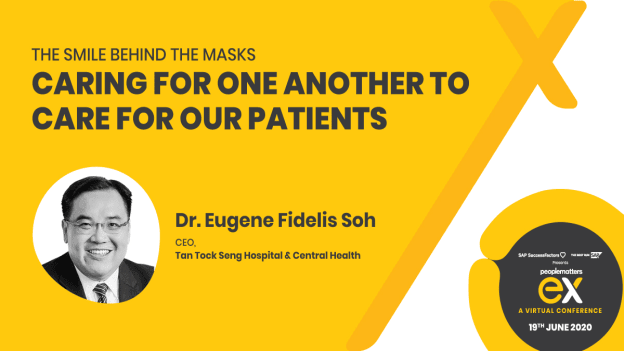The smile behind the masks: Caring for one another to care for our patients

Healthcare has always been first into outbreak, last of the outbreak and always in between. Responding to COVID-19, hospitals and healthcare workers in Singapore are fighting the enemy at the ground zero. And the Tank tock Seng Hospital is at the epicentre of Singapore outbreak response. Dr Eugene Fidelis Soh, CEO, Tank Tock Seng Hospital shared with us some of his learning from outbreak management at the People Matters EX Virtual Conference and some of the leadership lessons that we can learn from his experience beyond healthcare as an industry.
Crisis gives a chance to learn a lot about ourselves and the organization but what really matters is what happens in between crises. Tank Tock Seng Hospital is the front runner of Singapore against SARS in 2003, H1N1 in 2009 and now COVID-19 in 2020. An outbreak helps you learn unlearn and relearn to be able to set up the lessons for the next crisis.
With over 1,700 hospitals in total, operating with more than 2,000 beds per hospital for COVID-19 patients, TTS also has to make sure that their other services are regular for other patients. This becomes even more challenging as they need to make sure that all their workforce have to come together so that they can take care of them efficiently.
As the outbreak moves from an emerging phase to a containment phase and then to a recovery phase, they have to maintain a smooth process altogether. It starts with the front line, gradually moving towards the last line of the defence in this movement. As the cases gradually started to rise, it had to quickly ramp up the process and make sure that they cater to everyone. With every outbreak what matters most is the People.
Adoption of various procedures to be ready, to respond and to recover, only to be geared up for the next one is very crucial. The key to ready is to reinvent and innovate as no two outbreaks will be the same. The key to respond is to go beyond the stage of recharging and to be really able to renew so that we can establish a new normal going forward. The key to recover is being ready for relationships only to be ready for the next one.
Key states for outbreak management response: 5Ss
- Safety: The first and foremost leadership consideration to have is the safety. A sense of mutual care is really important especially in times of such crisis.This is the paramount response to any outbreak and so this is the first and foremost leadership consideration and drives the entire response.
- System: The second aspect of leadership consideration and behaving in the state of response is having good systems in place. They have built a 3Cs structure: Command, Control & Communication. A live 24*7 operating system to keep a check of the entire floor management system in real time, augmented by AI technology that allows to coordinate and have collective response as an organization. So with the intensity of the outbreak, the need of coming out with many subsystems within the hospitals is important to communicate effectively and respond well to the outbreak.
- Scalability: The third point in response goes to Scalability. This may sound very common, as during a crisis, the search for demand and response has to be one step ahead of the outbreak situation. There cannot be a disconnect between the reality and what you actually see on the shop floor. Scalability helps to form teams which are able to come up with new thoughts and facilities. It is also important to build culture across teams so that they can come together and fight this together, despite being miles apart.
- Surveillance: The fourth point in state of response goes to having a strong surveillance within the hospital. Surveillance is key because while they keep their eyes on the fireball coming right through the front door, it is also important to keep an eye on the back door. Creating a robust system, which starts from sickness surveillance to real time location tracking with CCTVs and video analytics to better understand the staff movement which helps us a lot to keep them safe.
- Sustainability: The last point in the state of response goes beyond search to sustainability, especially when we have a prolonged situation like COVID. It comprises three key aspects: The first is to have enhanced staff policies. The staff needs to have clarity about what the dos/don’ts. The clarity in training as it is very important. The second key is about engagement but it is kind of tricky. You often meet face to face every time but during an outbreak, because of the safe distance, the engagement has to go online. So you need to be updated and keep them engaged online and they can be aware of the latest policies and developments as well within the hospital. Installing a few chatbots which helps our staff stay updated with the policies and they can themselves simultaneously keep a check on the latest developments. The staff can also reach out in case they face issues at any given point of time. The third point of sustainability is interestingly equity. Now equity is a real concept. We have started working on COVID group and non COVID group which gives us the ability to recognize and differentiate which in turn helps ensure support and teamwork.
A sense of being newer:
- We have to have certain continuing measures extended beyond the outbreak as this will help to keep the curve flat and help us buy in time for the vaccine program to come in place, keep our staff and community safe. Hence so we need to keep up the continuous measures.
- We also need to adopt new habits and reinforce certain habits within our staff and our community. So safe distance, hand washing, and wearing a mask, making sure there is no transmission within the hospital and community.
- The third aspect is about hygiene measures. We need to redesign the hospital taking into account all the necessary measures to keep the environment safe and clean and our workplace safer for our staff.
Ensuring community health:
- The first one is about vaccinations. Not just waiting for the COVID vaccinations but also trying to reduce the noise of other infections within the community.
- Second, is how do we care about the population, especially the elderly and children, keeping mind about kinds of vaccines.
- Third: Strong COVID vigilance and sensing mechanism within the community which allows the hospitals to be ready and to be able to look at the type of recovery expected.
Changing care model:
- This will help us work together as a health system and will help keep in place the business continuity to make sure that our patients receive good care even in times of pandemic.
- The second part about changing care models is to have very strong care partnerships not just with healthcare providers but also with agencies and supply chain partners, government & private sectors who will be able to augment and support our work within the community.
- The third aspect of changing the care model is technology. Digitalizing the service at hospitals which will help the staff to better serve a lot of manual tasks will be taken care of also recording and coordination that happens within the hospital. This in turn gives us an opportunity to move in the space of digital health and care.
Building strong relationships:
- First aspect is planning: We have to be ready for the unknown. There might be a similar situation like this that we might have to face. The hospital has to plan for in terms of the capacity point of view, Capability point of view as well as the manpower readiness and augmentation point of view.The plans that we put in place needs to be modular and flexible to fight every kind of crisis.
- Second part is preparedness. The preparedness aspect comes in the form of exercises that we conduct. These exercises are basically situations that might happen on ground. Training of the staff with effective tools and treatments. These training greatly help during a pandemic situation wherein we need to make sure enough care is being taken care of.
- Third aspect is ensuring a healthy supply chain. During emergencies and outbreak, the supply chain is the most affected part. We need to move beyond the concept of hoarding/stocking up. We need to move beyond the point of resiliency and have the ability to produce and a system of trust.Through trust we can create a real time opportunity for the producers and users of our supplies. Ability to build partnerships wherein we are able to through technology wherein we are able to manage inventory in real time and keep monitoring the supply chain making sure it is strong enough to cater to the needs.
















